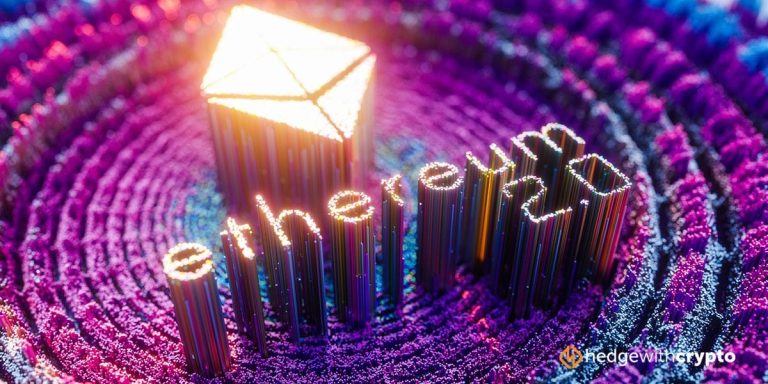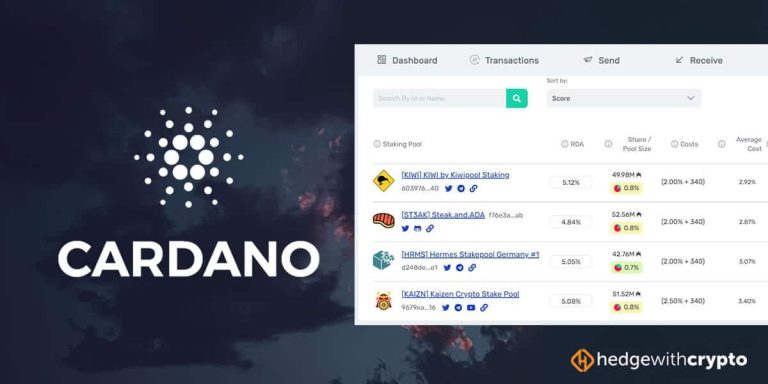We may earn a commission from links on our site, but this doesn’t affect our reviews. Learn more.
Hedge With Crypto is an independent publisher that provides objective and free content. Articles on our site may include links to our partners. If you click on these links, we may earn a commission. However, our editorial content remains unbiased, reflecting our own opinions or the general information available. For more information on our company policies, read the Affiliate Disclosure, Privacy Policy, and Terms & Conditions.
Where To Stake Polygon (MATIC)
Find out where you can stake MATIC, the fees involved, and how much you can earn.
Hedge With Crypto aims to publish information that is factual and accurate as of the date of publication. For specific information about a cryptocurrency exchange or trading platform please visit that provider’s website. This information is general in nature and is for educational purposes only. Hedge With Crypto does not provide financial advice nor does it take into account your personal financial situation. We encourage you to seek financial advice from an independent financial advisor where appropriate and make your own enquiries.
TABLE OF CONTENTS
Here are some of the best platforms to stake Polygon based on our reviews:
- Binance – Overall Best Place to Stake Polygon
- ByBit – Runner-Up Exchange to Stake MATIC
- KuCoin – Top Platform for Soft Staking
- Crypto.com – Large Exchange for Fixed and Flexible MATIC Staking
- Lido Finance – Liquidity Staking Platform
- MetaMask – Popular Wallet to Stake Polygon
The table below compares the estimated APY and staking fees on our list of top exchanges and wallets to stake Polygon.
| Platform | Polygon Staking Reward | Staking Fees |
|---|---|---|
| Binance | Up to 19.6% | None |
| ByBit | 0.55% | None |
| Crypto.com | Up to 14.5% | None |
| KuCoin | Up to 12.4% | 8% |
| Lido Finance | 8.7% and above | 10% |
| Metamask | Up to 6.52% | None |
Explaining The Best Places to Stake Polygon
The section below assesses the top ways to stake Polygon and earn rewards using crypto exchanges and wallets. Our review considers the staked amount, total supply, staking rewards, and other important factors.
1. Binance
Binance is our top pick for the best exchange to stake Polygon. Staking is one of the platform’s strong suits as it allows users to earn from hundreds of projects, including the Polygon network. Staking Polygon on Binance offers investors higher returns for longer contracts than other platforms and wallets. Plus, you had the backing of one of the most secure exchanges.
-
Trading Fees:
0.1% (spot) and 0.02% / 0.04% (Futures)
-
Currency:
USD, EUR, GBP, AUD, CAD, +22 Others
-
Country:
Global (USA allowed via Binance.US)
-
Promotion:
Up to $100 welcome bonus
MATIC staking on Binance is structured to earn investors more returns for locking up their coins for longer periods. The staking platform's lockup periods are 30, 60, and 90 days. There is an estimated ROI of 5.2%, 6.47%, and 19.6% APY, respectively. The total supply of these contracts in the Polygon staking pool is limited. All staking products are available on a first-come-first-serve basis. In most cases, the subscriptions sell out fast.
As expected, the staking product with a 30-day term to maturity comes with a much higher individual limit of 500,000 MATIC. For instance, if an investor stakes a maximum of 500,000 MATIC, they could earn about 2,137.05 MATIC coins as interest at the end of the contract. On the other hand, the 90-day staking product has a much lower individual limit of 250 MATIC.

We love that crypto users who stake MATIC on Binance get to keep 100% of their gains and digital assets. Binance does not charge investors for staking or unstaking their MATIC tokens on the platform. However, investors might find it a bit difficult to navigate the platform. Another issue is the time it takes to receive the staking rewards after unstaking MATIC tokens from the exchange wallet. It takes about 2 to 3 days to redeem the staked assets.
Despite these drawbacks, Binance is Polygon's best-rated staking platform, with its good rewards, flexible staking plans, and connection to other yield products under Binance Earn.
Read our full review on Binance Exchange.
2. ByBit
ByBit is known as one of the best margin exchanges for crypto due to its broad variety of markets and trading pairs to choose from. The exchange has recently introduced staking to its platform for its users to earn rewards. This includes Polygon which can be staked on ByBit for 0.55% APY. In short, ByBit is well-suited to frequent traders who want to earn a yield on their Polygon asset while trading on the world-class platform.
-
Trading Fees:
0% (spot), 0.06% / 0.01% (futures)
-
Currency:
USD, EUR, GBP, AUD, CAD, +125 Others
-
Country:
Global (USA not allowed)
-
Promotion:
0% trading fees for 30 days (spot only)
The only staking package for Polygon available on ByBit is a flexible term. The downside is that the staking rewards are generally lower, at least compared to Binance, which has fixed durations. However, given the mostly trader user base, ByBit is a great platform to earn staking perks on MATIC while holding Polygon within a wallet. Tokens accrue staking rewards on a daily basis and can be withdrawn at any time.
To stake on ByBit, a minimum amount of 150 MATIC tokens must be pledged to the staking pool. Similarly, a maximum investment of 30,000 MATIC can be delegated.
For details on the pros and cons of ByBit, read this review.

3. Crypto.com
Crypto.com is our next top option for staking Polygon in the Singapore-based Bitcoin exchange. Launched in 2016, Crypto.com is one of the top crypto apps for holding, selling, and buying MATIC and other crypto assets. The digital asset trading platform offers over 250 crypto assets that investors can trade while staking, with additional rewards for holding CRO tokens.
-
Trading Fees:
0.075%
-
Currency:
AUD, CAD, EUR, GBP, USD, BRL, and TRY
-
Country:
Global (USA Allowed)
-
Promotion:
None available at this time
Staking on Crypto.com is largely done on its mobile app and relies on its CRO token. The staking returns vary here, which can be perceived as complicated or disadvantageous. What determines the returns as an investor are a lockup period, how many staked CRO coins are available in a wallet, and the USD value of the crypto to be staked.
Crypto.com has three lockup periods. The platform has a one-month fixed-term, three-month fixed and flexible agreement. The fixed plans offer higher returns, but you can't withdraw your assets till the term expires. The flexible term allows investors to withdraw daily but comes with lower yields. Investors who stake Cronos coin (CRO) are awarded boosted returns on staking other cryptocurrencies.
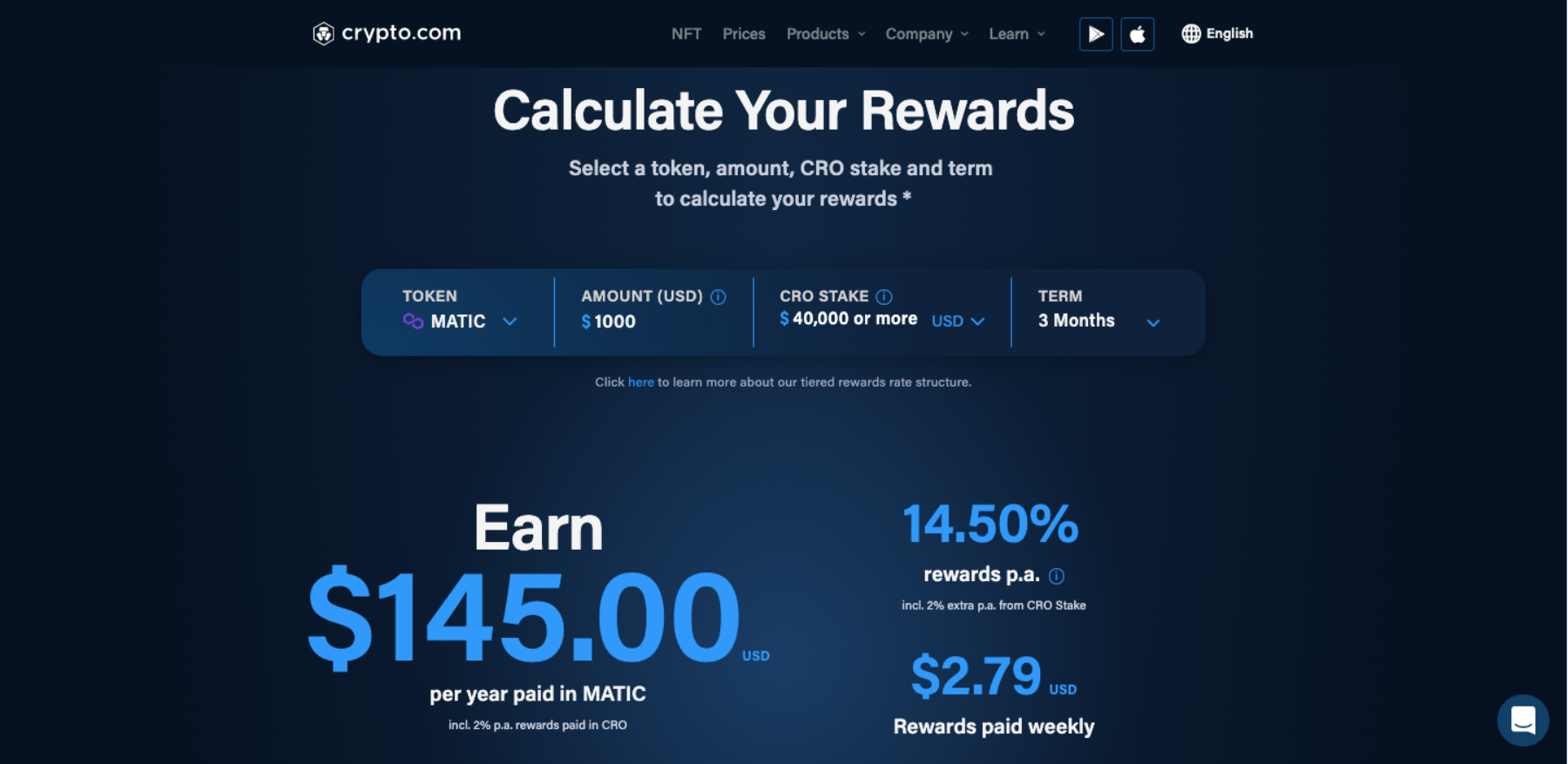
The higher the CRO tokens staked, the higher the yield from staking other coins. For example, an investor wants to stake $1000 of MATIC coins on a fixed 3-month schedule. If they have less than $4,000 CRO staked, the yields would be 11% APY and a bonus of 2% reward paid solely in CRO. If they increase your CRO holdings to about $7,000, the returns will jump to 12.5%. Higher CRO staking of $40,000 or more on a fixed three-month term comes with a 14.5% return. This is a high barrier to entry for most individuals. A major benefit is that staking Polygon on Crypto.com is entirely free, while rewards are paid weekly.
Moreover, Crypto.com has its advantages over the growing competition due to its unique ecosystem of staking services. With its debit card, users can easily spend their crypto assets and earn up to 5% cashback. Additionally, its CRO token is tied to a user's card, allowing them to earn staking rewards based on the tiers they fall under. Crypto.com Earn is also a top spot for earning as it allows users to earn more than one asset.
Find out more in our Crypto.com review.
4. KuCoin
KuCoin is a crypto exchange that allows millions of customers to buy, sell, and earn rewards on their crypto holdings. The platform offers crypto staking options for many cryptocurrencies, including MATIC. Staking Polygon on KuCoin is a breeze which is a major plus. The platform offers flexible and time-bound staking options (promotions) too.
-
Trading Fees:
0.1%
-
Currency:
USD, GBP, EUR, CNY & 46 others
-
Country:
Global (USA not allowed)
-
Promotion:
Up to 500 USDT in bonuses
Flexible staking on Polygon currently generates a meager 4.13% ROI, which is less competitive compared to other platforms in this list. The platform features several ongoing promotions, where investors can earn a maximum of 12.34% yields for 30 days. KuCoin offers daily interest payouts.
A two-week staking option in the promotions segment pays 9.27% interest on staked MATIC. Customers can subscribe to any of the available staking products. Subscription to KuCoin's staking feature is on a first-come-first-service basis. Moreover, KuCoin charges its customers 8% in fees to maintain its delegation pools. This is at the upper band of staking fees and commissions.
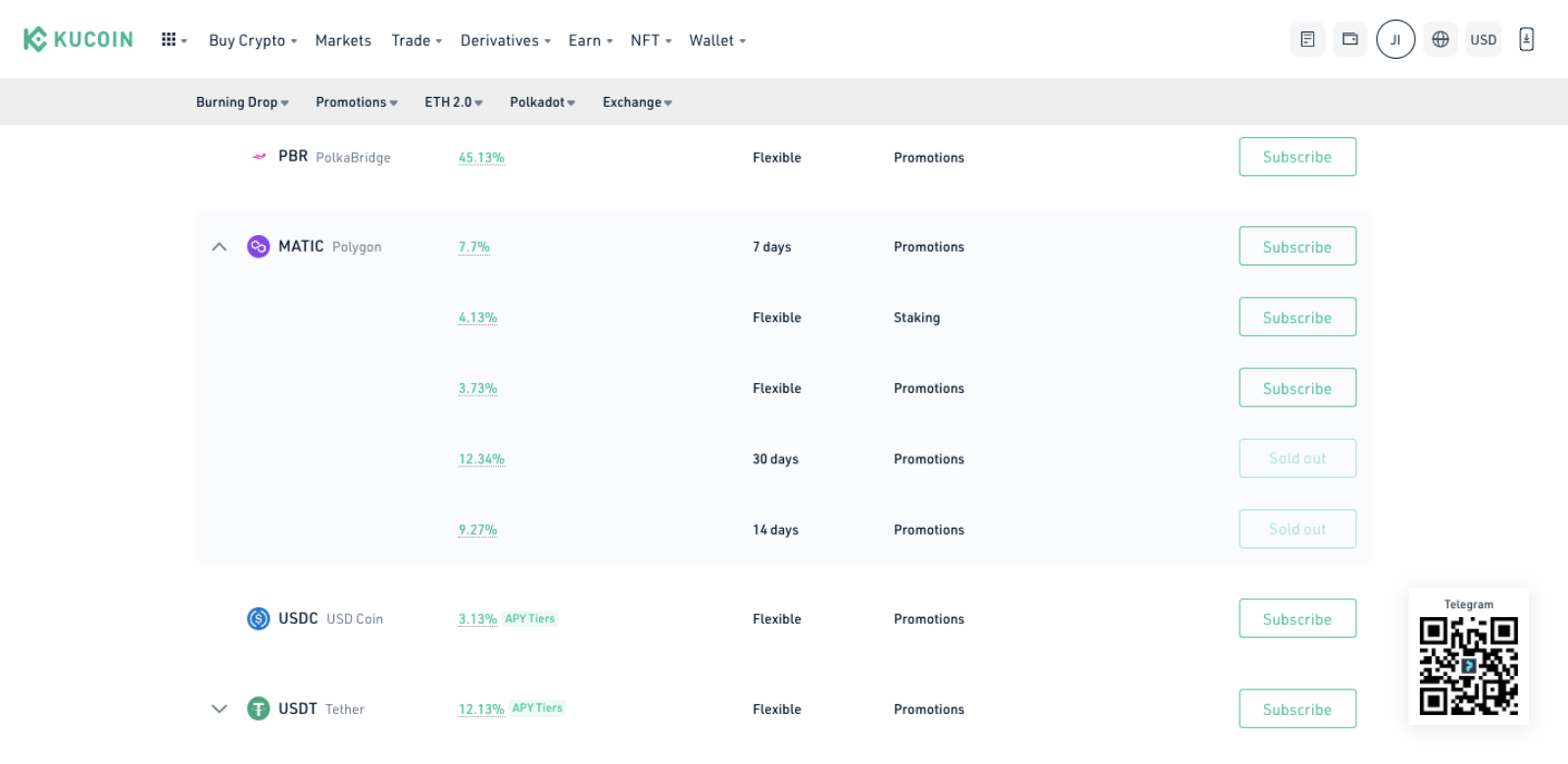
KuCoin also offers a soft staking feature which is one of the easier ways to stake crypto that follows the ethos of Lido Finance. The soft staking system allows investors to earn rewards on their cryptocurrencies without locking them up, which can be advantageous for traders who want to stake MATIC with idle funds.
Learn more about the platform in our KuCoin review.
5. Lido Finance
Lido Finance is one of the premier staking platforms in the space. The platform aims to simplify staking while ensuring that users’ funds are secure and productive. What makes the platform stand out is its liquidity staking system.
Users can mint new tokens based on their staked assets one-to-one. These minted tokens track the same pricing data and are redeemable for the original token. They are usually identified with the ‘st’ before their ticker symbol. Investors who stake MATIC on Lido are rewarded with the stMATIC token. These minted tokens can be used on the secondary market, like on decentralized finance (DeFi) platforms, to generate multiple yields on initial investments. This way, a lockup concept is absent in the Lido ecosystem.
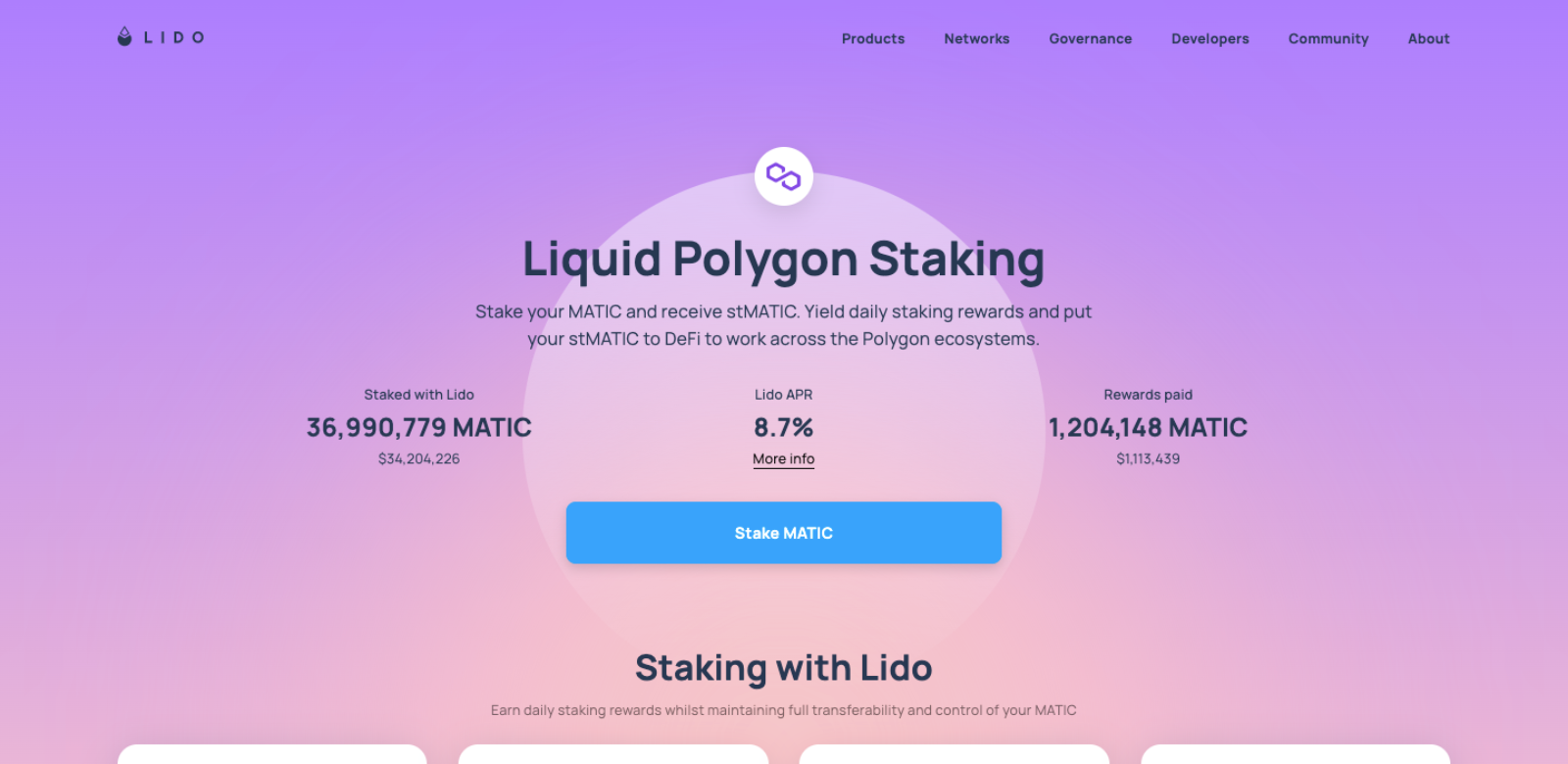
Annual returns on Lido's MATIC staking start from 8.7% APY. There are no lockup periods. Investors can redeem their tokens anytime they want. However, the platform charges a 10% reward fee on all earnings generated which is the highest staking fee on this list and should be considered.
6. Metamask – Best Decentralised Wallet to Stake Polygon
Metamask is a top Ethereum digital wallet that allows users to store their digital assets. The platform mostly interacts with the Ethereum network but is also customizable with multiple blockchain networks. Staking is not a native function of the Metamask wallet. However, the platform can be integrated with a host network to put idle crypto assets to work. The average ROI for MATIC staking is 6.52% APY.
To stake Polygon tokens, an investor can start by visiting the official Polygon Staking website from the wallet and select a validator with a stellar track record on the network. The next step will be to tap on ‘Delegate’ and connect a Metamask wallet that contains the MATIC coins. Once done, set the amount of MATIC tokens to be staked and follow the onscreen prompts to finish the steps. They will need ETH coins in the MetaMask wallet to fund the transaction cost.
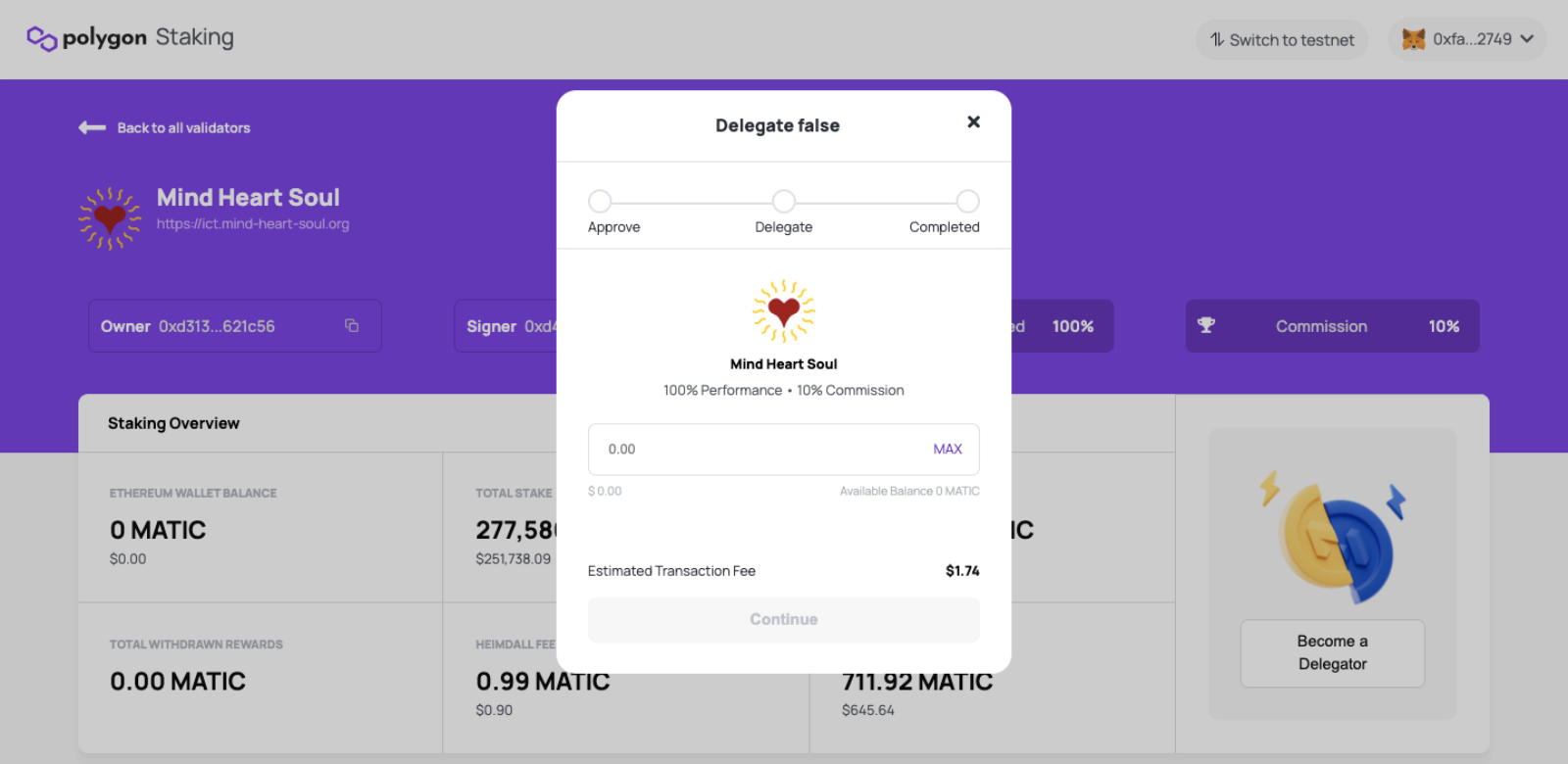
Investors can filter based on their track record to choose the best validator. Validators can be categorized based on the amount of Polygon staked, checkpoints signed, and commissions. The staked amount shows the total amount staked by the validator, including coins delegated to them.
Validators with less than 100% can have their staked coins slashed by the network or lose rewards if they fail to upgrade. The ‘Commission’ tab talks about the percentage of the rewards that go to the validator. The validator decides the minimum limit and maximums to be staked. Staking Polygon through Metamask can be expensive as all transactions must be completed using the Ethereum blockchain, which means users must own ETH to pay for gas fees. While a viable option to stake MATIC tokens, the Metamask wallet is not as user-friendly compared to the top selections above, such as Binance, Crypto.com, and KuCoin.
Read our Metamask wallet review to find out more.
The Basics Behind Polygon (MATIC)
MATIC is the native token for Polygon. The digital asset powers most activities on the decentralized network, including governance and staking. Holders of the Polygon crypto can vote on the protocol's operations and stake the digital asset for economic incentives. The MATIC token has shown great potential as the digital asset was one of the top performers in 2021, earmarked by crypto events. The digital asset hit an all-time high (ATH) of $2.92 in December 2021, up more than 31,000% from an all-time low (ATL) value of $0.003021 in 2019.
Meanwhile, the value of digital assets has plummeted with the broader crypto market, as it has shed 63% of its record value in the last several months. The digital asset is returning to its previous value as it has surged more than 54% in the last month, pointing to a growing bullish trend.
Key Takeaways:
- MATIC is the utility token of the Polygon network.
- It facilitates transactions on the network and is used for voting, trading, and staking.
- The digital asset had a stellar 2021, rising more than 31,000% from its 2019 low price to $2.92 in a two-year gap.
- Despite a market downtrend, MATIC is still up 54.54% in the last month.
This Is What's Involved
Polygon staking involves locking up MATIC tokens to secure the Polygon network for a determined period. This decentralizes the network’s operations and makes it harder to hack than a platform with a centralized architecture. Stakers generate MATIC tokens in return for securing the network. The MATIC token is also useful for settling network fees and for governance purposes.
When investors lock up their funds in a staking pool, they delegate their tokens to a validator to run nodes on the network. These nodes are then used to reinforce the Polygon network's security apparatus, and rewards earned are shared according to the number of tokens staked. So, the more an investor stakes, the more rewards they get. Users have two choices to earn Polygon MATIC tokens. First, they can become validators and run full nodes on the network. This option involves users engaging in self-staking, requiring a minimum stake amount of 1 MATIC.
Polygon validators run the Heimdall Validator and Bor block-generating nodes that keep the blockchain operational. MATIC validators are chosen via an on-chain auction. Those chosen can serve as both validators and block producers. However, the downside is that a validator can forfeit their staked tokens if found to have committed punishable behavior. This could result from an average uptime or double-signing of blocks.
Investors can also become delegators, where they collaborate with others to secure the network. Delegators are crypto users who can't run a validator node themselves. Instead, they ‘delegate' their tokens to a validator to earn a percentage of the rewards. Since delegators share their rewards with their chosen validator, they also share the risks. If the validator commits a punishable behavior, the delegator is at risk of having their stake slashed in proportion to their stake. This is common for Proof-of-stake tokens that are delegated to pools.
The Earning Potential of Staking MATIC
Although the answer to this question largely depends on the number of validators at a particular time, the Polygon network has allocated about 12% of its 10 billion tokens to staking rewards. This means about 1.2 billion tokens are given to users to secure the network. Polygon's annual percentage yield (APY) is currently set at 14.3% for validators and delegators on its website. A top crypto exchange like Binance offers ROI for MATIC staking that range between 4% and 19% within a 90-day window. However, these interest rates are subject to frequent changes and are available first-come-first-serve.
The Fees
No, the Polygon network doesn't charge transaction fees for staking coins. Also, the network is gasless, so there are no gas fees. However, investors must pay a fee to transfer their coins. This fee is usually negligible – below a dollar in most cases. In addition, using staking platforms such as KuCoin and Lido Finance charges a commission fee of 8% and 10%, respectively.
Pros of Staking Polygon
- Generate Rewards on Idle Crypto. The primary benefit of staking coins is the returns investors generate for delegating their coins. Traders can put their idle crypto to work if they are not actively trading the markets.
- Contribute to the Network’s Success. Staking has the singular mission of securing the network and decentralizing operations. This is crucial to ensuring the network does not have a single point of failure so that the chance of being hacked by a malicious actor is reduced (here's a list of recent Defi hacks). By staking, users are essentially ensuring the continued operation of the network and its potential success.
- Vote. Utility tokens like MATIC don’t perform only one function. Aside from earning rewards from their tokens, investors can use them to vote. This way, they can contribute to any network proposals or upcoming projects.
Cons of Staking Polygon
- No Access to Funds. Staking coins means the coins will be inaccessible for a particular period. While some platforms like Binance offer ‘Flexible’ earning options, investors will still be unable to do much until the unlocking period resolves. Under Binance Locked Staking, unlocking and redeeming the funds takes about 48-72 hours.
- Value May Drop. While traders gain more tokens from staking, the overall value of the staked assets may drop during the lockup period. This may cause investors to lose some of their fiat valuations as they can't transfer or trade the assets during the lockup period.
- Slashing. Staking also comes with a penalty system. Given its unique role, mistakes are not permitted. They are often penalized. If a validator or delegator makes a verification mistake or suffers a slow internet connection, their tokens are slashed by half.

